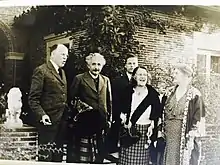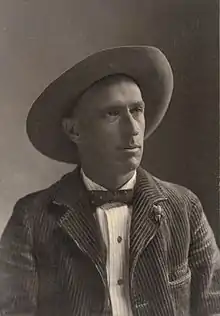Dorothea Rhodes Lummis Moore
Dorothea Rhodes Lummis Moore (November 9, 1857 – March 4, 1942) was an American physician, writer, newspaper editor, and activist.
Dorothea Rhodes Lummis Moore M.D. | |
|---|---|
.jpg.webp) "A woman of the century" | |
| Born | November 9, 1857 Chillicothe, Ohio, U.S. |
| Died | March 4, 1942 (aged 84) California, U.S. |
| Nationality | American |
| Education | New England Conservatory of Music, Boston University School of Medicine |
| Occupation | physician, writer, newspaper editor, activist |
| Relatives | Charles Fletcher Lummis, Ernest Carroll Moore |
Moore was born in Chillicothe, Ohio, 1860. Her father was Josiah H. Rhodes, of Pennsylvania Dutch stock, and her mother, Sarah Crosby Swift was descended from a New England family. Although a successful student of music in the New England Conservatory of Music, in Boston, in 1881, she entered the medical school of Boston University, and graduated with honor in 1884. In 1880, she married Charles Fletcher Lummis, and in 1885, removed to Los Angeles, California, where she began the practice of medicine. She served as dramatic editor of the Los Angeles Times and also musical editor and critic on that journal. She was instrumental in the formation of a humane society which was brought about through her observations of the neglect and cruelty to the children of the poor, and Mexican families, visited in her practice; and the establishment of the California system of juvenile courts.[1] She was a writer for Puck, Judge, Life, Women's Cycle, San Francisco Argonaut, and the Californian, as well as contributing many important papers to the various medical journals of the United States.[2] Having divorced Charles Lummis in 1891, she married secondly Dr. Ernest Carroll Moore in 1896. She was a confidante of Charlotte Perkins Gilman,[3] and a life-long friend of Mary Austin.[4] Moore died in 1942 in California.
Early years and education
Mary Dorothea Rhodes was born in Chillicothe, Ohio, November 9, 1860. Her parents were Josiah H. Rhodes, of Pennsylvania Dutch ancestry, and Sarah Crosby Swift, of New England Puritans ancestry. Several brothers and a sister died in infancy. In 1868, the family moved to Portsmouth, Ohio.[5]
Dorothea entered the Portsmouth Female College, and at the age of sixteen years was graduated as B.A. and was the salutatorian of her class. Two years later, she went to Philadelphia, Pennsylvania, and entered Mme. Emma Seller's conservatory of music. She remained two years, learning some music and hearing a great deal of the best in concert and opera, and reading indiscriminately and superficially everything that was found on the shelves of the Public Library, that looked interesting. Later she went to Boston, Massachusetts, and studied music under James O'Neil of the New England Conservatory of Music.[5]
Career
On April 16, 1880, at Boston,[6] she secretly married Charles Fletcher Lummis, who was then a student at Harvard University. In 1881, she entered Boston University School of Medicine, and graduated with honors in 1884, thought he flunked out before then and went to work for her parents in the Scioto River area of Ohio. Initially engaged in farming, he became a journalist on the Scioto Gazette before he accepted a position with the Los Angeles Times in 1884.[1] During the last year of her college life, Moore served as resident physician in the New England Conservatory of Music. In 1885, she joined her husband in Los Angeles, where she began to practice medicine. She was highly successful in her practice, obtaining prompt recognition from her fellow physicians. She served as president and secretary of the Los Angeles County Medical Association, and as corresponding secretary of the Southern California Medical Society. In her practice, after finding much cruelty and neglect among the children, chiefly of the Mexican-Americans, and among animals, she formed a humane society, and brought the cases of neglect and cruelty into the courts.[5]
Moore served as dramatic editor of the Los Angeles Times, and later, the musical editor and critic of that journal. She also did some notable literary work. She contributed to Kate Field's Washington, Puck, Judge, Life, Woman's Cycle, the Home-Maker, the San Francisco Argonaut and The Californian. She was a member of the Pacific Coast Women's Press Association, and contributed many important papers to the various medical journals of standing in the United States.[5]
Personal life
In 1891, she divorced Lummis.[4] In March of that year, he married Eve Frances Douglas, of Connecticut, in San Bernardino, California, and their daughter, born in 1892, was named Dorothea, the same as his first wife.[7]

On February 17, 1896, she married Dr. Ernest Carroll Moore.[8] Ernest had been a resident of Hull House during his student days in Chicago (1896–98),[8] while Dorothea, ten years his senior, was a teacher there,[9][10] In her vacation tours, she visited many of the Native American pueblos in New Mexico, and made a collection of arrowheads, Navajo silver and blankets, Aconia pottery, baskets and other curios of that area.[5] In 1911, she moved from Los Angeles to New Haven, Connecticut.[11] June 26, 1912, Moore and Dr. Mary F. McCrillis, a homeopathic physician of Evanston, Illinois, sailed away for two months abroad.[12] In 1913, she moved from New Haven to Cambridge, Massachusetts.[13]
Moore was an invalid for several years before her death.[10] She died March 4, 1942 in California, and was buried at Forest Lawn Memorial Park in Glendale, California. Her letters are held in the Dorothea Rhodes Lummis Moore Collection at the Huntington Library in San Marino, California.[14]
Selected works
- At Sunset
- A Neglected Mission
References
- Gullett 2000, p. 141.
- Logan 1912, p. 741.
- Rudd & Gough 1999, p. 69.
- Henry E. Huntington Library and Art Gallery 1979, p. 244.
- Willard & Livermore 1893, p. 478.
- Harvard College (1780- ). Class of 1881 1892, p. 54.
- Harvard College (1780- ). Class of 1881 1898, p. 108.
- Marquis 1915, p. 757.
- Sicherman 2003, p. 123.
- Scarborough & Furumoto 1989, p. 188.
- Journal Publishing Company 1911, p. 77.
- Hahnemann Hospital of Chicago 1912, p. 403.
- Recorder Publishing Company 1913, p. 283.
- Padget 2006, p. 231.
Attribution
 This article incorporates text from a publication now in the public domain: Hahnemann Hospital of Chicago (1912). The Clinique: A Monthly Abstract of the Clinics and of the Proceedings of the Clinical Society of the Hahnemann Hospital of Chicago. 33 (Public domain ed.). Authority of the Hospital Board.CS1 maint: ref=harv (link)
This article incorporates text from a publication now in the public domain: Hahnemann Hospital of Chicago (1912). The Clinique: A Monthly Abstract of the Clinics and of the Proceedings of the Clinical Society of the Hahnemann Hospital of Chicago. 33 (Public domain ed.). Authority of the Hospital Board.CS1 maint: ref=harv (link)  This article incorporates text from a publication now in the public domain: Harvard College (1780- ). Class of 1881 (1898). Secretary's Report: V (Public domain ed.). George H. Ellis.CS1 maint: ref=harv (link)
This article incorporates text from a publication now in the public domain: Harvard College (1780- ). Class of 1881 (1898). Secretary's Report: V (Public domain ed.). George H. Ellis.CS1 maint: ref=harv (link)  This article incorporates text from a publication now in the public domain: Harvard College (1780- ). Class of 1881 (1892). Fourth Report of the Secretary of the Class of 1881 of Harvard College (Public domain ed.). Matthews-Northrup Company.CS1 maint: ref=harv (link)
This article incorporates text from a publication now in the public domain: Harvard College (1780- ). Class of 1881 (1892). Fourth Report of the Secretary of the Class of 1881 of Harvard College (Public domain ed.). Matthews-Northrup Company.CS1 maint: ref=harv (link)  This article incorporates text from a publication now in the public domain: Journal Publishing Company (1911). The Pacific Coast Journal of Homeopathy. 22 (Public domain ed.). Journal Publishing Company.CS1 maint: ref=harv (link)
This article incorporates text from a publication now in the public domain: Journal Publishing Company (1911). The Pacific Coast Journal of Homeopathy. 22 (Public domain ed.). Journal Publishing Company.CS1 maint: ref=harv (link)  This article incorporates text from a publication now in the public domain: Logan, Mrs. John A. (1912). The Part Taken by Women in American History (Public domain ed.). Perry-Nalle publishing Company. p. 741.CS1 maint: ref=harv (link)
This article incorporates text from a publication now in the public domain: Logan, Mrs. John A. (1912). The Part Taken by Women in American History (Public domain ed.). Perry-Nalle publishing Company. p. 741.CS1 maint: ref=harv (link)  This article incorporates text from a publication now in the public domain: Marquis, Albert Nelson (1915). Who's who in New England: A Biographical Dictionary of Leading Living Men and Women of the States of Maine, New Hampshire, Vermont, Massachusetts, Rhode Island and Connecticut (Public domain ed.). A.N. Marquis & Company. p. 757.CS1 maint: ref=harv (link)
This article incorporates text from a publication now in the public domain: Marquis, Albert Nelson (1915). Who's who in New England: A Biographical Dictionary of Leading Living Men and Women of the States of Maine, New Hampshire, Vermont, Massachusetts, Rhode Island and Connecticut (Public domain ed.). A.N. Marquis & Company. p. 757.CS1 maint: ref=harv (link)  This article incorporates text from a publication now in the public domain: Recorder Publishing Company (1913). The Woman's Medical Journal. 23 (Public domain ed.). Recorder Publishing Company.CS1 maint: ref=harv (link)
This article incorporates text from a publication now in the public domain: Recorder Publishing Company (1913). The Woman's Medical Journal. 23 (Public domain ed.). Recorder Publishing Company.CS1 maint: ref=harv (link)  This article incorporates text from a publication now in the public domain: Willard, Frances Elizabeth; Livermore, Mary Ashton Rice (1893). A Woman of the Century: Fourteen Hundred-seventy Biographical Sketches Accompanied by Portraits of Leading American Women in All Walks of Life (Public domain ed.). Moulton. p. 478.CS1 maint: ref=harv (link)
This article incorporates text from a publication now in the public domain: Willard, Frances Elizabeth; Livermore, Mary Ashton Rice (1893). A Woman of the Century: Fourteen Hundred-seventy Biographical Sketches Accompanied by Portraits of Leading American Women in All Walks of Life (Public domain ed.). Moulton. p. 478.CS1 maint: ref=harv (link)
Bibliography
- Gullett, Gayle (7 February 2000). Becoming Citizens: The Emergence and Development of the California Women's Movement, 1880-1911. University of Illinois Press. ISBN 978-0-252-09331-9.CS1 maint: ref=harv (link)
- Henry E. Huntington Library and Art Gallery (1 January 1979). Guide to American Historical Manuscripts in the Huntington Library. H. E. Huntington Library and Art Gallery. ISBN 978-0-87328-100-3.CS1 maint: ref=harv (link)
- Padget, Martin (2006). Indian Country: Travels in the American Southwest, 1840-1935. University of New Mexico Press. ISBN 978-0-8263-3029-1.CS1 maint: ref=harv (link)
- Rudd, Jill; Gough, Val (1999). Charlotte Perkins Gilman: Optimist Reformer. University of Iowa Press. ISBN 978-0-87745-695-7.CS1 maint: ref=harv (link)
- Scarborough, Elizabeth; Furumoto, Laurel (March 1989). Untold Lives: The First Generation of American Women Psychologists. Columbia University Press. ISBN 978-0-231-05155-2.CS1 maint: ref=harv (link)
- Sicherman, Barbara (2003). Alice Hamilton: A Life in Letters. University of Illinois Press. ISBN 978-0-252-07152-2.CS1 maint: ref=harv (link)

